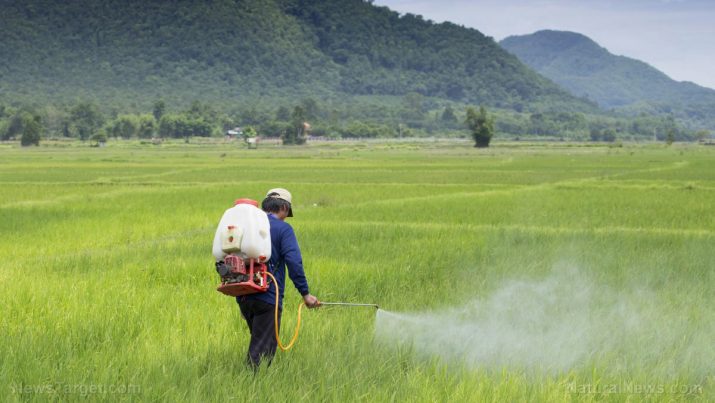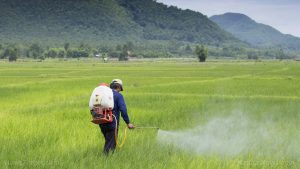
Butachlor — toxicity, side effects, diseases and environmental impacts
Saturday, December 02, 2017 by Earl Garcia
http://www.naturalpedia.com/butachlor-toxicity-side-effects-diseases-and-environmental-impacts.html

The International Union of Pure and Applied Chemistry website classifies butachlor as a synthetic and systemic herbicide. The chemical is used to mitigate the growth of annual grasses and broad-leaved weeds such as barnyard grass, crab grass and torpedo grass as well as witch grass and red deadnettle. The herbicide works by inhibiting cell division and subsequent germination of weeds. It is commonly applied to staple crops including rice, wheat, barley, and peanuts.

List of known side effects
Butachlor exposure is particularly detrimental to the central nervous system’s overall health. The chemical is known to induce excitation, seizures and tremors as well as ataxia, agitation, and nervousness. More serious conditions such as amnesia, central nervous system depression and coma may also occur following the exposure. The systemic herbicide is also found to target both male and female reproductive health. Exposure to the chemical may increase the risk of depressed sperm counts and sperm motility. Likewise, the herbicide may affect the quality of the placenta.
The toxic chemical is also notoriously dangerous to the respiratory tract. Inhaling the chemical is known to result in pneumonitis and respiratory failure. An article posted on the Toxicology Data Network website also reveals that the poisonous compound is highly toxic to heart health. According to the entry, butachlor exposure may lead to hypotension, dysrhythmias, and sensitized myocardial tissue. Other conditions associated with the chemical include liver necrosis, blood dyscrasias, renal failure, and thrombocytopenia.
Furthermore, a Pub Chem article also notes that butachlor may pollute water sources and compromise aquatic animals including fishes, invertebrates and crustaceans. Likewise, the chemical is known to affect aquatic plants, algae and sediment dwelling organisms. The harmful substance is also detrimental to soil health and impact beneficial organisms such as earthworms and arthropods.
Body systems affected by butachlor
Butachlor exposure may negatively affect the central nervous system. Likewise, the toxic chemical may compromise both the respiratory tract and the cardiovascular system. The herbicide is also known to impact reproductive health, overall blood circulation and urinary profile.
Items that can contain butachlor
Butachlor is the primary ingredient in many commercially available herbicides such as Machete, Weedout, Butanox and Vendaval. It comes in both emulsifiable concentrate and granule formulations.
How to avoid butachlor
An entry posted on the Chemical Book website recommends wearing protective clothing, gloves, and respiratory equipment to reduce the risk of pyraclostrobin exposure. The data sheet also advises that workplaces install adequate ventilation to lower the odds of exposure. The safety guidelines stress that people exposed to the toxic fungicide should contact a poison control center or seek immediate medical help. The safety guidelines also recommend that people immediately evacuate the area to avoid direct contact if an accidental spill occurs.
Where to learn more
- Autism, brain and CNS disorders overwhelmingly linked to people in close proximity to pesticide spraying
- Overused fungicides give rise to deadly, resistant fungus threatening humans and crops
- Fungicide chemicals found to produce autism-like symptoms in animal studies, causing inflammation of the nervous system
- Denmark discovers an alarmingly high concentration of pesticide poisoning in their population – school children are especially vulnerable
- AUTONOMOUS PLANES now weaponized as pesticide delivery platforms to inundate farmland with toxic chemicals
- Exposure to common fungicide causes neurological problems across four generations
Summary
Butachlor exposure may induce seizures, amnesia, central nervous system depression, and coma.
Butachlor may cause pneumonitis and respiratory failure, hypotension, dysrhythmias, and sensitized myocardial tissue
Butachlor raises the odds of liver and tissue necrosis, blood dyscrasias, renal failure, and thrombocytopenia.
Butachlor primarily affects both the respiratory system and the reproductive health.
Butachlor is detrimental to both the respiratory tract and the cardiovascular system.
Butachlor may negatively affect the body’s overall blood circulation and renal health.
Sources include:
Tagged Under: Tags: Butachlor





